Cutting free of conventional aesthetics during years of work with Le Corbusier and Pierre Jeanneret, Charlotte Perriand turned to working with wood. Four years spent in Japan were crucial to her maturation, but it was after the War that she developed her personal conception of housing to the full, endowing her creations with a human dimension and achieving a synthesis of the traditional and the industrial.
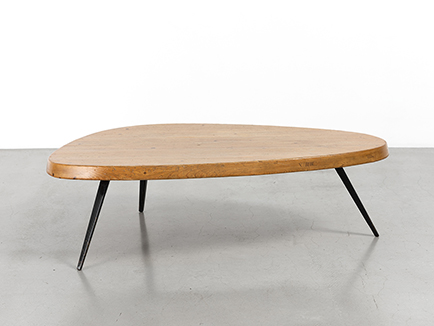
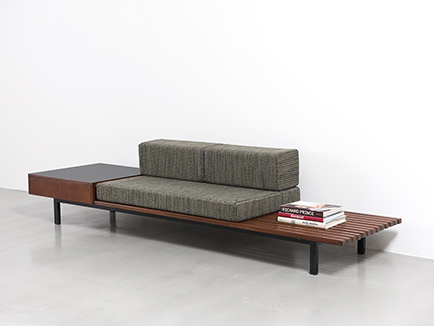
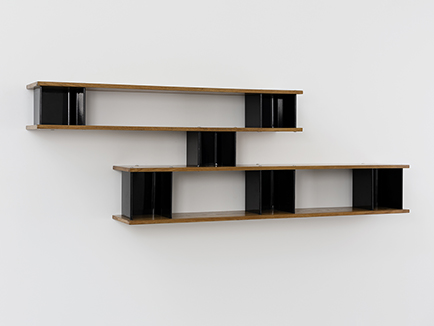
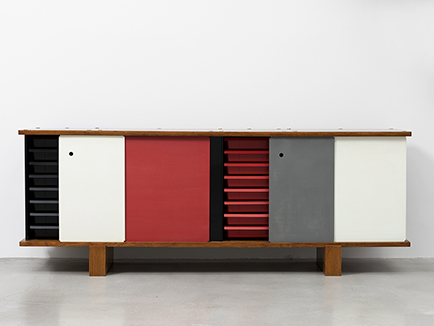

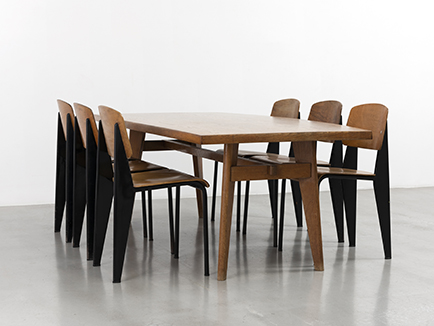
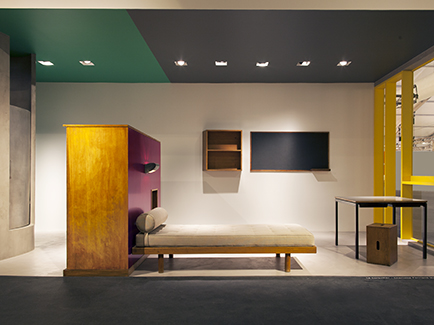
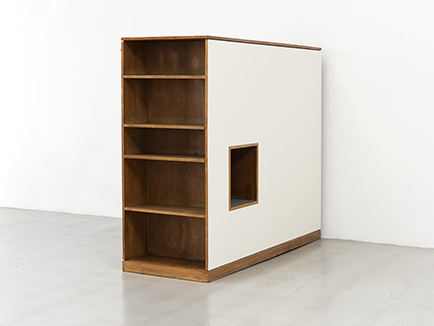
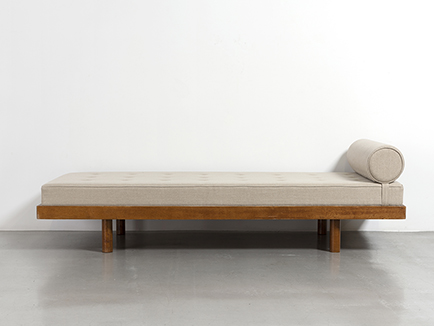
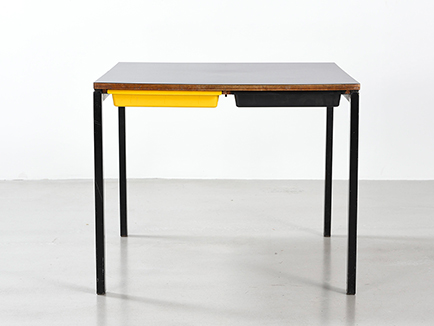
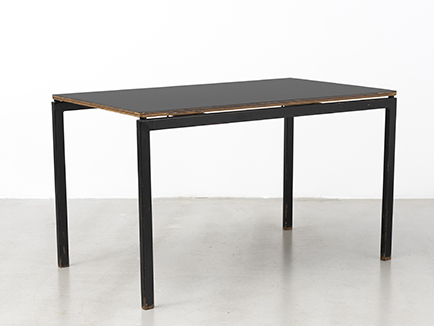
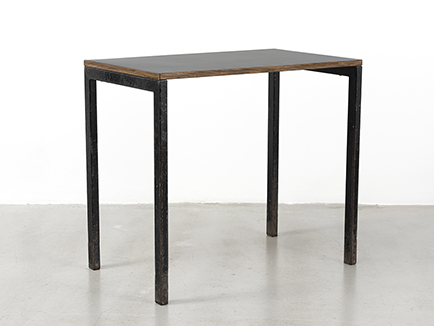
CHARLOTTE PERRIAND
1920-1925
Accepted with a scholarship at the Union Centrale des Arts Décoratifs school.
In the meanwhile:
– followed the teaching of Maurice Dufrène, Artistic director of the Galeries Lafayette school
– at the Grande Chaumière; also followed the teaching of Bernard Boutet de Monvel
– appeared at André Lhôte’s atelier
– regularly made animal sketches at the Jardin des Plantes zoological garden.
1925
At the International Exhibition of Arts she presented, within the framework of the Union Centrale school:
– a project, called Eupalinos or The Architect, after the work by Paul Valéry, carried out by the bookbinding workshop
– a fresco, the Nine Muses, intended for a Music Room
– a wrought iron gate
– at Maurice Dufrène’s stand, soft furnishings edited by Galeries Lafayette.
1926
Decorative Artists Exhibition – Living room corner.
1927
Decorative Artists Exhibition – set of silverware and lighting fixtures.
Was appointed active member.
Beginning of research and completion of metal furniture and lighting fixtures.
Influence of the mechanization era: coach-building design, bicycle, ball bearings. She broke off completely with conventional Decorative Art. Found a studio on Place Saint-Sulpice, which she laid out anew: bar, dining room – this being presented at the Salon d’Automne and the Decorative Artists Exhibition.
At the Salon d’Automne – the bar in the garret, chromed steel and anodized aluminum.
Full membership – Praised by journalists.
1928
Decorative Artists Exhibition.
Formed a small avant-garde group with René Herbst and Jo Bourgeois, including jewelry showcases by Jean Fouquet and Gérard Sandoz, silverware by Jean Puiforcat, and wine-tasting glasses for the Nicolas stores.
Exhibited her 1928 Dining room: Extensible table, swivel seats, chromed tubing structures.
1927-1937
At the Le Corbusier-Pierre Jeanneret studio, rue de Sèvres, she took part in the various projects
as a student of architecture, and worked as an associate in charge of furniture.
Noteworthy are the following:
1928, Fittings for Villa Laroche,
1928-1929, Villa Church at Ville-d’Avray,
1929, Preparation of the “House fittings” section for the Decorative Artists Exhibition. Asked for a group stand, renewing and widening the 1928 avant-garde group idea. This was refused by the Decorative Artists Committee. Charlotte Perriand then resigned, followed by the whole group, who later founded the Union of Modern Artists (“Union des artistes modernes”: UAM).
1929
At the Salon d’Automne.
Le Corbusier, Pierre Jeanneret, Charlotte Perriand presented: House fittings, sets of compartments, seats, tables. This furniture was later edited by Thonet, with each piece once sold bearing an identification symbol which read “Thonet-Le Corbusier-Pierre Jeanneret-Charlotte Perriand”.
1930
Official creation of the Union des artistes modernes: UAM.
First exhibition in June at the Musée des Arts Décoratifs, with designers from all spheres of activity, from architecture to objects.
Laying-out of the Editor’s office, La Semaine, Paris.
Charlotte Perriand fitted out a music room for Jean Rivier, a composer.
She left her studio on place Saint-Sulpice to settle in the Boulevard du Montparnasse.
1931
Exhibition in Cologne: Le Corbusier, Pierre Jeanneret, Charlotte Perriand presented a diorama of the Plan Voisin with various furniture elements: chaise longue, sets of compartments placed on a carpet-manifesto.
At the same time, she joined the AEAR (Association of Revolutionary Students and Artists; Secretary-General: Jean Nicolas, an Ecole Boulle alumnus).
1930-1933
Travel to the USSR. Visited the building site of Centrosoyus, the Central Cooperatives Bureau in Moscow.
1932-1937
Preliminaries to the 1937 International Exhibition.
As early as 1932, Le Corbusier suggested as a program an international exhibition on habitat, opening an era of large-scale work à la Haussmann, as a first section of the great East-West “backbone” of Parisian urban design. This program was never implemented.
From 1935 to 1936, Charlotte Perriand carried out studies and research work in view of a group action involving all members of CIAM and UAM, mentioning the sites and nature of their participation.
– For the Kellerman bastion in the fortifications of Paris, a project for a Dwelling Unit (“Unité d’habitation”) to be built by Le Corbusier and co-workers;
– Project for a House of Young Artists and Technicians: “Youth 37 Project»;
– The “Bazar»: Francis Jourdain wanted to take stock of daily items on the market, by selecting the most interesting ones.
These projects were not implemented – they were not taken into account by the curators in charge of the 1937 exhibition.
1933
Participated in the IVth Congress of CIAM on board the Patrix II, between Athens and Marseilles; on the following theme: “Towards a functional city ”.
1935
At the Brussels International Exhibition.
Maurice Dufrène, in charge of the French section, gave Louis Sognot, René Herbst & Charlotte Perriand the necessary funds for the presentation of the House of the Young Man. They agreed to work as a group within an “exploded” architecture.
– Bathroom & Bedroom: Louis Sognot.
– Physical training room with a fresco by Fernand Léger: René Herbst.
– Study: Charlotte Perriand, Le Corbusier, Pierre Jeanneret.
1936
In a magazine, “Vendredi”, launched by André Chamson, “A Free Press for Free Men”, an interview with Charlotte Perriand, questioned by the general public “The Housewife and her home”: practical hints, text & drawings.
At the Salon des arts ménagers (Modern Homes Exhibition). III Exhibition on the subject of Dwellings, organized by “l’Architecture d’aujourd’hui”. Demonstration with contemporary dwellings, with A. Hermant, M. Barret, F.P. Jourdain, A. Louis, J.P. Sabatou, P. Vago. Charlotte Perriand presented a living room with a selection of Flambo metal filing cabinets, to which she added seats and tables of her own creation, as well as a photomontage on poverty in Paris.
In the meanwhile she carried on various research works on: family hostels, mountain hotels, week-end houses.
At the Ministry of Agriculture: waiting room for the Office of the Cabinet Minister, Georges Monnet, who asked her to combine and express graphically, for that room, statistics concerning the most important problems facing agriculture, and to highlight the main points of the Popular Front’s agricultural platform.
1937
Within the International Exhibition, the UAM obtained its own area, & built its pavilion, wherein:
– Le Corbusier, Pierre Jeanneret, Charlotte Perriand presented a prototype for a sanitary cabin, intended for hotels and manufactured by Jacob Delafon;
– Charlotte Perriand, Pierre Jeanneret, André Tournon, engineer, presented: the Refuge bivouac with l’Aluminium français, within the framework of high mountains equipments, as a reaction against the Refuge Vallot.
– Charlotte Perriand presented several collapsible or combinatory seats. At the Porte Maillot, on an area devoted to agriculture, Georges Monnet greeted the new program presented by Le Corbusier – Pierre Jeanneret “Le Pavillon des Temps nouveaux” ; a large canvas tent accommodating the program: Dwelling & Leisure, as well as the Vth CIAM Congress.
At the Porte Maillot, near the Temps nouveaux pavilion, together with Fernand Léger, Charlotte Perriand illustrated the platform of the Ministry of Agriculture, using panels arranged on an outdoor structure built by H. Pacon and M. Detourbet, architects.
Charlotte Perriand ended her collaboration with the Le Corbusier studio.
1936-1938
Research and Raw Art (“Art Brut”) photographs with Pierre Jeanneret and Fernand Léger.
1938
First formed tables: a dining room table made of fir beams from the Pavillon des Temps Nouveaux.
1939
Hotel extension in the Saint-Nicolas-de-Véroce valley.
Experimental setting up of the “Refuge bivouac” on the Mont Joly ridge, department of Haute-Savoie.
Study for a mountain hotel in the new winter sports resort of Méribel-les-Allues.
1940
Together with Jean Prouvé, Pierre Jeanneret, Georges Blanchon, creation of an office, in the rue Las-Cases, for the study of prefabricated buildings for l’Aluminium Français.
February 8, invited by the Ministry of Commerce and Industry of Japan, as an arts and crafts expert.
June 14, she sailed off Marseilles on the Hakusan-Maru.
August 22, arrival in Tokyo after a long detour through South Africa.
1940-1941
Resided in F.L. Wright’s Imperial Hotel in Tokyo. Her duty: to act as an adviser on the production of arts and crafts.
March 1941 in Tokyo, May 1941 in Osaka.
Opening of the “Tradition, selection, creation” exhibition in the Takashimaya department stores, under the patronage of the Ministry of Commerce and Industry, and of the French Embassy.
1942
>Wrote, together with J. Sakakura, her book entitled « Contact with Japan », which summarizes and illustrates the various themes of her exhibition.
1943-1946
Left Japan to stay in Indochina.
August 15, 1945: surrender of Japan.
February 1946, departure for France on board a cargo boat for refugees.
April 1946, Paris, resumed her activities.
1946-1949
At Méribel-les-Allues, resumed study on the resort on a renewed basis. Paul Grillo and Christian Durupt, architects.
1947
At the International Exhibition of Urban Planning and Dwelling in the Grand Palais, fittings for a Minimum Family House, with P. Nelson, R. Gilbert, CH. Sebillote; architects.
At Paul Nelson’s study, participation in the project for the Saint-Lô Memorial Hospital.
1948
Studies and standardization for a domestic storage unit: the drawer and its accessories, patented in several materials: metal, plastics …
1949
At the Musée des Arts Décoratifs, the members of UAM carried out Francis Jourdain’s Le Bazar project, as opposed to usual Exhibition practice.
1950
For Le Corbusier’s Dwelling Unit in Marseilles: study and manufacture of a prototype kitchen.
At the Modern Homes Exhibition (“Salon des arts ménagers”), Dwelling section, presentation of a model cell for Le Corbusier’s Dwelling Unit, in Marseilles: Charlotte Perriand in charge of furniture & fittings.
1950, Special issue of the journal Techniques et Architecture: “Art d’habiter” (The Art of Dwelling”).
1951
At the Modern Homes Exhibition: fittings for a prototype intended for a building in Toulon: Jean de Mailly, architect. IXth Milan Triennal Exhibition, Useful Forms & Fittings section. French participation headed by Charlotte Perriand.
1952
At the Modern Homes Exhibition, Useful Forms section: exhibition of a Toilet cum shower & bath set.
At the House of Tunisia, in the International Students’ Residence, Jean Sebag, architect; the Espace group, founded by André Bloc, tried a synthesis between Architecture, Fittings, and Plastic arts. Painters such as Nicolas Schöffer, Sonia Delaunay, took part in this venture; through a dialogue with them Charlotte Perriand fitted out a student’s room.
Study and creation of toilets with Jean Borot: top-hung toilet ramp; bidet.
Fittings for the Air France building in Brazzaville. Charlotte Perriand worked together with the Jean Prouvé study, in Nancy.
1953
The Student’s House in Paris (Lagneau & Weill, architects), creation of various fittings, including a study; tables elaborated with Jean Prouvé and A. Salomon, lighting engineer.
Hôtel de France in Conakry (Lagneau & Weill, architects). Fittings by Charlotte Perriand and Jean Prouvé.
1955
“Synthèse des arts” Exhibition in Tokyo – with the collaboration of J. Sakakura and Martha Villiger.
1957
At the Modern Homes Exhibition, a synthesis of the traditional Japanese “Art of Dwelling”.
Selection of items made by the Takashimaya department stores, in collaboration with J. Sakakura and Sori Yanagi.
Japanese House created by Ren Suzuki with the help of “Elle” magazine.
This event was organized under the patronage of the French Ministry of Education and the Japanese Embassy in Paris.
1958
The House of the Sahara, within the Modern Homes Exhibition, a project intended for the oil industry. Charlotte Perriand, Jean Prouvé, Lagneau, Weill, Kowalsky, architects.
1959
Fittings for rooms and public spaces of the House of Brazil at the International Students Residence by Le Corbusier and Lucio Costa. In collaboration with the Steph Simon Gallery.
Renovation of Jean and Huguette Borot’s house, in Montmartre, with Henri Prouvé, architect.
Air France Tokyo branch building, with J. Sakakura and Ren Suzuki
1960
Chalet at Méribel-les-Allues, Savoie.
French Tourist Office, London, with Erno Goldfinger, architect.
1962
Individual flat in Rio in collaboration with Maria Elisa Costa, architect.
1962-1968
Frequent travels to Brazil and Latin America.
1962
Contest for the equipment of three winter sports resorts in the Vallée des Bellevilles, Savoie – Ch. Perriand, J. Prouvé, Candilis, Wood, Josic.
1964
Direct agreement between Fondation Le Corbusier and Cassina for the exclusive edition of 1929 creations by Le Corbusier – P. Jeanneret – Ch. Perriand.
1965
At the Musée National d’Art Moderne in Paris, furniture items for the presentation of publications by the Réunion des Musées Nationaux, reception desk and museum cashdesks, in collaboration with Pierre Faucheux.
1966
Residence of the Japanese Ambassador in Paris. J. Sakakura, Riedberger, architects.
1959-1970
United Nations Council in Geneva for the modernization of Conference rooms and of the great Assembly room. Beaudouin & Carlu, architects.
1966-1968
Consultant for the regional Fine Arts & Applied Arts School in Besançon.
1968
Participation in an international conference organized by UNESCO in Kyoto: “The Japanese contribution to Contemporary Arts. The relationship between Japanese and Western Art: Architecture, Literature, Music, Theater”.
1970
Restructuring of a flat in Paris.
1967-1982
Launching and building of Les Arcs resort, in Savoie. Inauguration of the first bed for Christmas, 1968. 18,000 beds, built January 1st, 1982 distributed between three resorts at 5,250, 5,900 and 6,600 feet above sea level, out of a programmed total of 30,000 beds.
Creator, developer and operator: Roger Godino, a former Ecole Polytechnique alumnus, founder and Dean of the Faculty, European Institute of Business Administration in Fontainebleau. Charlotte Perriand was entrusted with the setting up of a Technical Research Department in Architecture and Engineering, which she was to lead during the fourteen years between 1967 and 1982.
This department was subdivided into several branches:
– The Mountain Architecture Study Group, in Chambéry, headed by R. Regairaz, G. Rey-Millet and A. Bardet.
This group, which had carried out overall location studies, working with Robert Blanc and Emile Allais, brought to bear its long historical experience of mountain resort building, notably with Pradelle at Courchevel.
– The Faucheux, Taves, Rebuto group, which was introduced into the project by Charlotte Perriand, especially on the basis of their former work with Le Corbusier. Its members were to bring about a renewal of the architectural spirit.
– Bernard Taillefer, a former carpenter from Val-d’Isère, a self-taught man become architect after his achievements at Les Arcs.
He contributed a new and reliable way of treating space with wood, his favorite material. Moreover, Jacqueline Eberhard, from Paris, and R. Boulet, from Moutiers, were to intervene on some programs, and Jean Prouvé accepted to give precious advice at various intervals.
“Dès 1600”, an agency created by Arc Mobilier for the furnishing of studio apartments to let, and, through its retail outlets, for offering the public a supplement in the form of original items.
Investigation and selection by Charlotte Perriand.
1983
December, participation in a mission to China headed by Godino in Beijing and Jilin (Manchuria) for the equipment of a winter sports resort.
Dialogue on Architecture in China with local engineers and architects.
1983-1984
Presided the Jury at the International Contest for the creation of new office furniture, organized by the French Ministry of Culture.
1984
Retrospective at the Musée des Arts Décoratifs, entitled « Charlotte Perriand: an Art of Living ».
1999
October, 27: death in Paris aged 96.